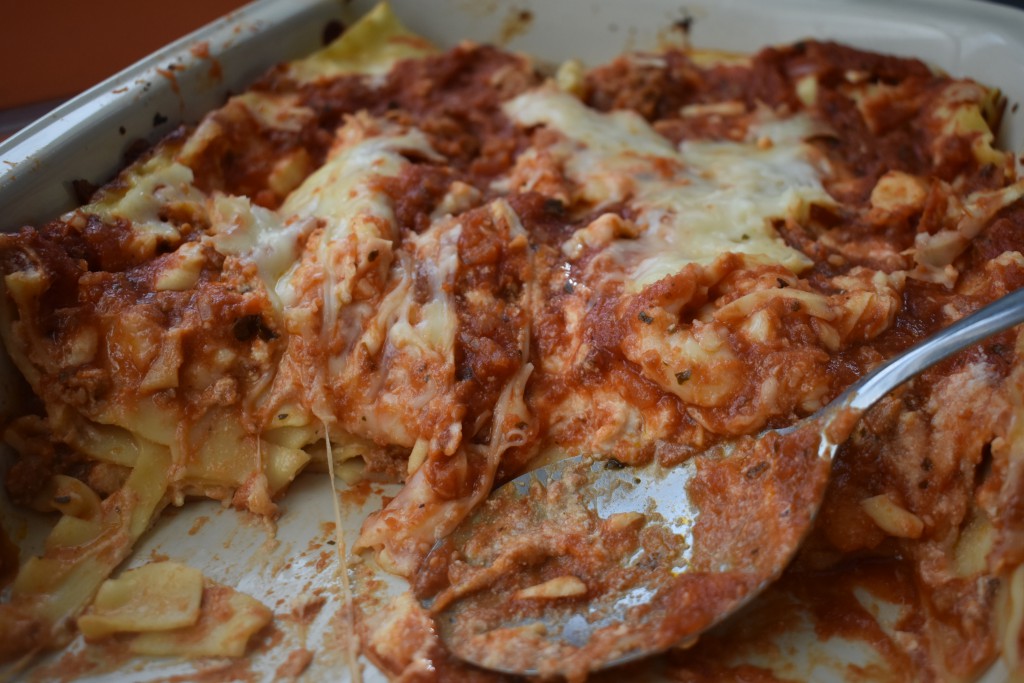
The best thing about lasagna? It doesn't have to be beautiful to be amazing. photo by AJ Domagala
A five layer analysis on one of Italy’s most famous dishes
Layer One: Lasagna History
Contrary to popular belief, the classic Italian dish known today as lasagna did not directly originate from Italy. It is debated among culinary historians as to which country documented the first real recipe. The roots of the dish can actually be traced as far back as ancient Greece, with the name “lasagna” being derived from the Greek word “laganon,” which was the name of the earliest known form of pasta. The original dish, slightly different from today’s lasagna, consisted of layers of noodles and sauce. This was the first trace of the of dish, and all though it did not utilize the classic Italian ingredients commonly used today, it provided the framework for the dish. One of the first recorded recipes was found in the Liber de Coquina (Book of Cookery), a recipe book containing a full set of lasagna ingredients dating back to the 14th century shrouds the origins of the modern household lasagna in a tasty layer of mystery. It is no doubt that the dish was perfected in Italy, as it is one of the country’s most renowned dishes. Several forms of the dish have been created since, as the techniques and ingredients used to make the classic dish continue to evolve and match the climate of the modern kitchen.
Layer Two: The Sonorous Section – Meat
Throughout the ages, humankind has always asked the question: What meat should be put to my lasagna? There is no official meat used to prepare the dish, however a recurring use of ground beef in classic style lasagnas suggests this meat may be an original ingredient. The list of applicable meats doesn’t end there, however; sausage and pork are also commonly found in the dish. The classic recipe even got a taste of the bacon epidemic, as several recipes have recommend its use in the dish. The neutral palate of lasagna when concerning meats allows for the mixture of several kinds. While slightly less common than red meats, some recipes and styles of lasagna might even include meats such as chicken, turkey, and even fish. The action doesn’t stop in the vegetarian scene either, with common meat substitutes such as squash and zucchini, as well as mixed portions of chopped vegetables such as carrots, spinach, and peppers. In this symphony of culinary arrangement, the meat acts as the rhythm, serving as a base to the rest of the delicious ensemble.
Layer Three: The Strings – Sauce
Like in any classic Italian dish, the sauce can determine the quality of the the overall finished product, and can also serve as one of the most complex and customizable elements of the dish. Think of it as the soft and elegant string family in the consumable orchestra that is lasagna. The most commonly used type of sauce is the classic bolognese, although a simple marinara sauce is also widely applicable to the dish. Bolognese style sauce combines a tomato-based red sauce with a creamy milk-based white sauce, often including ground beef. Marinara sauce, on the contrary, is solely tomato-based, and is composed of tomato paste, diced tomatoes, and spices such as oregano and salt. Because of its lack of meat, a simple marinara, or red sauce, is often used to make vegetarian style lasagna. Overall, there is a lot of wiggle room as far as sauces go for lasagna. This makes a variety of sauces, whether store-bought or homemade, viable in the creation of a good dish.
Layer Four: The Triumphant Brass – Cheese
Triumphant when necessary, much like the brass in an orchestra, the cheese can also provide some low undertones, as a bass saxophone or a tuba might provide in an ensemble of instruments. There are very few lasagnas that don’t contain some form of ricotta cheese. It gives it that nutty aroma and aftertaste lasagna is known for. In addition to the classic ricotta, a base cheese of mozzarella is commonly used. Parmesan is another classic choice for lasagna. This cheese is no stranger to Italian dishes, being used as a base cheese in some of Italy’s most famous recipes, such as chicken parmesan, chicken marsala, as well as the simple spaghetti and meatballs. If using an oven, Cheese is almost always added before the baking process, allowing it to melt and perform at its full potential.
Layer five: The Conductor: Pasta
Noodles are the music stands, the chairs, the printers of the sheet music, the reeds for each clarinet, and the stage. In charge of the entire symphony is the classic lasagna style pasta. These are very important because the dish is quite literally named after its style of noodle. The only thing keeping this dish from being a mess of delicious ingredients is the pasta. While the architecture of the pasta almost always remains the same, the only difference between the varying kinds is whether or not they are non-boil. Non-boil lasagna noodles are exactly what one might think, as they don’t require cooking in their preparation. The non-boil noodle type allows for several styles of lasagna, including the skillet lasagna, which is cooked entirely in a skillet pan over a stovetop. The noodles are an element to lasagna that rarely varies, a centerpiece of the delicious dish called “Lasagna.”